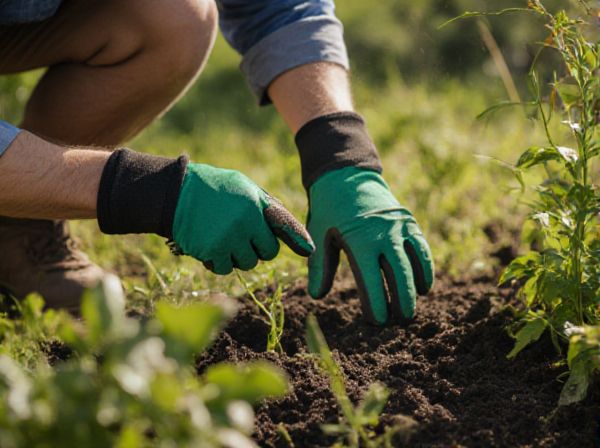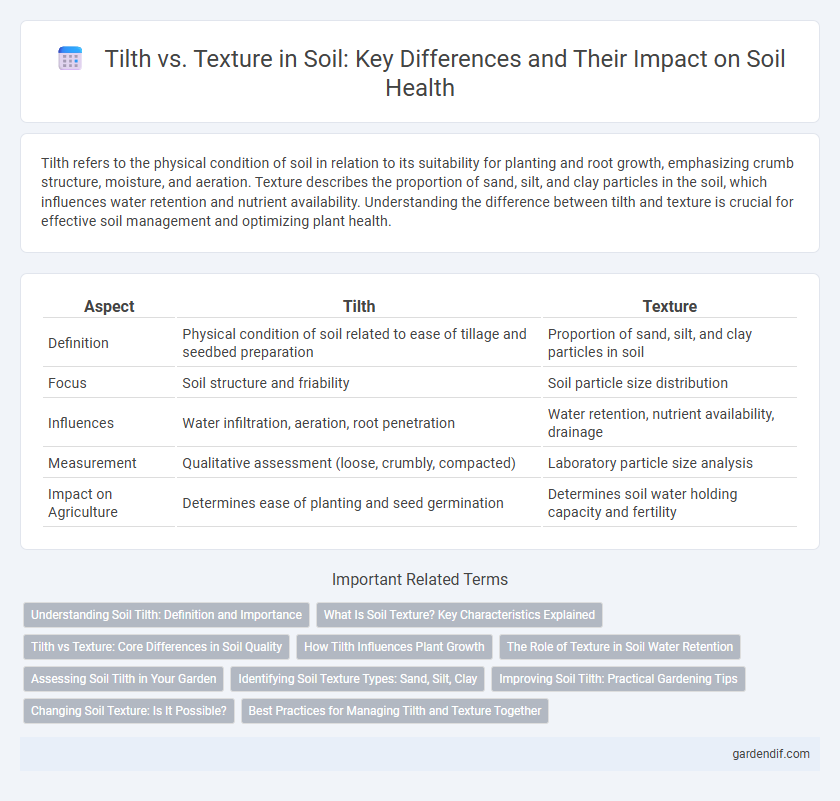
Tilth vs Texture Illustration
Tilth refers to the physical condition of soil in relation to its suitability for planting and root growth, emphasizing crumb structure, moisture, and aeration. Texture describes the proportion of sand, silt, and clay particles in the soil, which influences water retention and nutrient availability. Understanding the difference between tilth and texture is crucial for effective soil management and optimizing plant health.
Table of Comparison
| Aspect | Tilth | Texture |
|---|---|---|
| Definition | Physical condition of soil related to ease of tillage and seedbed preparation | Proportion of sand, silt, and clay particles in soil |
| Focus | Soil structure and friability | Soil particle size distribution |
| Influences | Water infiltration, aeration, root penetration | Water retention, nutrient availability, drainage |
| Measurement | Qualitative assessment (loose, crumbly, compacted) | Laboratory particle size analysis |
| Impact on Agriculture | Determines ease of planting and seed germination | Determines soil water holding capacity and fertility |
Understanding Soil Tilth: Definition and Importance
Soil tilth refers to the physical condition of soil that is ideal for planting and growing crops, characterized by a crumbly texture, good aeration, and moisture retention. Unlike soil texture, which is determined by the proportion of sand, silt, and clay particles, tilth emphasizes the soil's structural qualities that influence root penetration and water movement. Proper soil tilth improves nutrient availability and supports healthy plant growth, making it a critical factor in sustainable agriculture and soil management.
What Is Soil Texture? Key Characteristics Explained
Soil texture refers to the relative proportions of sand, silt, and clay particles that determine its feel, structure, and drainage properties. Key characteristics of soil texture include particle size distribution, which affects water retention, aeration, and root penetration, with sandy soils draining quickly and clay soils holding moisture longer. Understanding soil texture is essential for managing fertility and crop suitability in agricultural practices.
Tilth vs Texture: Core Differences in Soil Quality
Tilth refers to the physical condition of soil regarding its suitability for planting, emphasizing crumb structure and ease of root penetration, while texture describes the relative proportions of sand, silt, and clay particles. Good tilth improves aeration, water retention, and nutrient availability, factors not directly indicated by soil texture alone. Understanding both contributions is essential for optimizing soil quality and promoting healthy plant growth.
How Tilth Influences Plant Growth
Tilth, the physical condition of soil as related to its suitability for planting, influences plant growth by affecting root penetration, water retention, and aeration. Unlike soil texture, which is determined by particle size distribution, tilth reflects structural qualities like crumb size and aggregation that impact nutrient availability and microbe activity. Optimal tilth promotes healthy root development and improves moisture and oxygen access, directly enhancing plant vigor and yield.
The Role of Texture in Soil Water Retention
Soil texture, determined by the proportion of sand, silt, and clay particles, critically influences water retention capacity by controlling pore size distribution and water holding ability. Fine-textured soils like clay have smaller pores that retain more water, while coarse-textured sandy soils drain quickly and hold less moisture. Understanding soil texture helps optimize irrigation practices and crop selection for improved water use efficiency in agriculture.
Assessing Soil Tilth in Your Garden
Assessing soil tilth involves evaluating the soil's structure, moisture retention, and ease of cultivation to ensure optimal plant growth. Unlike soil texture, which refers to the relative proportions of sand, silt, and clay particles, tilth reflects the soil's physical condition and crumbly consistency that supports root development and water infiltration. Gardeners can improve tilth by incorporating organic matter and avoiding compaction, leading to healthier crops and enhanced nutrient availability.
Identifying Soil Texture Types: Sand, Silt, Clay
Soil texture is determined by the relative proportions of sand, silt, and clay particles, with sand particles being the largest, clay the smallest, and silt in between. Identifying soil texture types is crucial because sand provides good drainage but poor nutrient retention, silt holds moisture and nutrients better, and clay has high nutrient content but poor aeration and drainage. Understanding the balance of these textures helps optimize soil tilth, which refers to the soil's physical condition and ability to support plant growth.
Improving Soil Tilth: Practical Gardening Tips
Improving soil tilth involves enhancing the soil's physical condition to promote better air and water movement, root penetration, and microbial activity. Incorporate organic matter such as compost or aged manure to increase aggregation and moisture retention, while avoiding excessive tillage that can degrade soil structure. Applying mulch and practicing crop rotation also help maintain tilth by protecting the soil surface and supporting nutrient cycling.
Changing Soil Texture: Is It Possible?
Changing soil texture is a complex process because soil texture is determined by the relative proportions of sand, silt, and clay particles, which are naturally stable over time. While texture itself cannot be quickly altered, soil tilth--the physical condition related to aggregation and structure--can be improved through organic matter addition, cover cropping, and reduced tillage. Enhancing soil tilth increases porosity, water retention, and root penetration, effectively optimizing soil performance despite the inherent limitations of texture modification.
Best Practices for Managing Tilth and Texture Together
Optimal soil management integrates both tilth and texture to enhance plant growth and water retention capacity. Regular organic matter incorporation improves soil structure, boosting tilth by increasing aggregation without altering the inherent texture, which is defined by the sand, silt, and clay proportions. Employing practices such as reduced tillage and cover cropping maintains aggregate stability and prevents compaction, effectively balancing tilth quality with the soil's natural texture characteristics.
Tilth vs Texture Infographic

 gardendif.com
gardendif.com